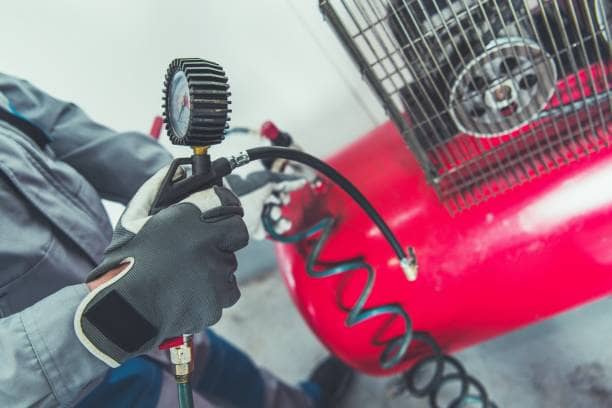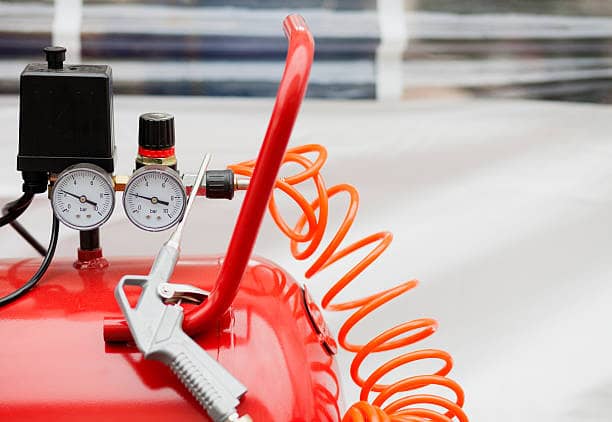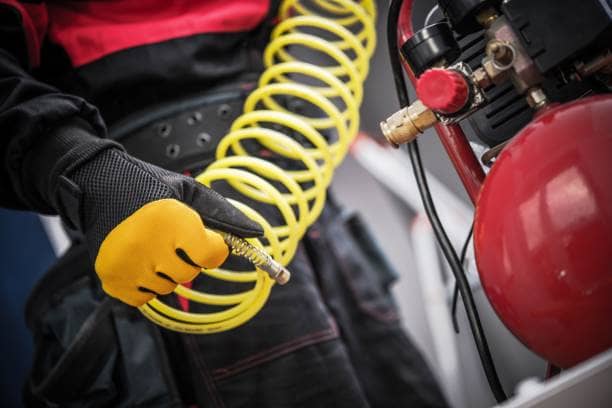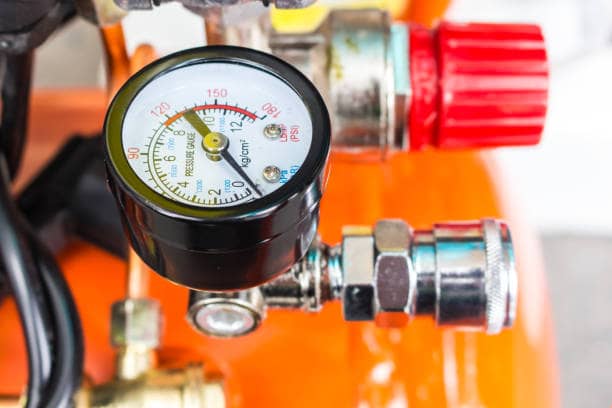Compressors are helpful with various mechanical and carpentry and.
Like any device and tool, knowing how to care for and use a compressor can significantly differentiate between complete frustration and easy use.
For example, a pneumatic nail gun will not drive nails to the proper depth unless you adjust your compressor correctly.
Too low pressures will make nails fully sit in the lumber, while too high pressures will make nails sink too deep, causing indentations in your lumber.
Now, let’s find out how to adjust the air compressor pressure switch.
How To Adjust Air Compressor Pressure Switch?
Before getting started, we recommend consulting your owner manual for a guide regarding the adjustments you need.
You can also find it on the manufacturer’s website. If this is not possible for you, let’s jump on the guide below.
Step 1: Located the Pressure Switch
You will need to start by removing the pressure switch cover of your compressor. It is a plastic cover (usually black) on top.
To remove it, you need to use a Phillips screwdriver to turn the screw on this cover counterclockwise. Then put this cover aside.
Step 2: Identify Your Device’s Cut-Out Pressure Setting
Plug in your device and turn the switch (on/off) to the automatic or on position. After that, your machine will start instantly. Let it run till it shuts off.
Keep an eye on the air gauge of your machine while it’s running, and note the pressure reading when your device stops. It is the compressor’s cut-out setting.
Step 3: Mount Hose to Your Compressor’s Nozzle
Attach the hose to your compressor by pulling back on the air fitting. Then, slide this fitting onto the nozzle of your device.
Next, release the hose nozzle and mount a tool to the hose’s opposite end in the same way.
Step 4: Release the Air and Read Cut-in Number
Push your device’s handle on the blowgun to release air while tracking the gauge, showing a decrease as the air escapes the tank.
Note the pressure reading when your compressor restarts. This is the cut-in reading. Wait a while until your machine stops.
Step 5: Customize Cut-In Pressures
Prepare one Allen wrench (or another tool) to turn the main calibration screw of your machine to the right to advance the cut-in pressures.
The main calibration screw is above the differential adjustment one, and the metallic screw is left.
You should refer to your owner’s manual to determine each adjustment screw accurately.
Twist the screw to the left to reduce the cut-in pressures.
Test them by bleeding air out of your compressor and replicating these procedures until the correct cut-in pressures are reached.
Step 6: Customize Differential Pressure
Adjust your compressor cut-out pressures by rotating the differential pressure screw using one flat screwdriver.
Rotate the screw counterclockwise to reduce the differential or clockwise to raise the differential.
Bleed air from your compressor as the first adjustment, and note the pressure reading on the gauge.
Keep bleeding and customize until you reach the proper cut-out pressures.
Step 7: Reinsert The Pressure Switch Cover
Secure screw your plastic cover back over the pressure switch with Use one Phillips screwdriver
Why Should You Adjust The Pressure Switch?
It is essential to ensure your compressor has the proper pressures to run pneumatic tools efficiently and optimally.
Higher pressure might be detrimental to the compressor and your tools.
The pressure switch control is one of the most important and basic settings in compressors that any owner should know.
It determines how much air is necessary to operate one pneumatic device. When setting the pressure controller, you should realize that less is better!
For example, lowering the pressure settings is needed if your compressor is set at 125 PSI, while your pneumatic tools recommend lesser pressure settings.
If the suggested pressure settings of your pneumatic tools are exceeded, chances are they will get damaged!
The key is always to adjust the air based on the specific pneumatic tool. It will save you costs and energy in the long run.
In addition, your pneumatic tool and compressor also suffer less wear and tear and last longer.
Some Things To Consider Before Adjusting
Most compressors have internal pressure switches that control the “cut out” and “cut in.” It means when the motor turns off and turns on and.
This is called the differential value. The ‘cut out’ occurs when compressors are full. The manufacturer will set the time between “cut in” and “cut out.”
You can reduce the time between these values to lower the pressure. You can increase it by increasing the differential value. Yet, we do not recommend this.
In poorly maintained compressors, everything higher than suggested pressures might prove dangerous.
Remember that pressure switches come in two types. One has an adjustable pressure differential, while the other has a fixed differential value.
You should read your owner’s manual to determine the kind of switch you have.
What Is Compressor Used For?
You probably already know that the compressor provides the air for pneumatic tools and is mainly used for mechanical and carpentry areas.
But that is not all! You may be surprised if you know that these devices have more applications than you think.
Workshops
Electric and petrol compressors allow you to drive power tools in machine shops or for personal use.
Smaller tools, such as impact wrenches and nail guns, require small machines, while more powerful units work well for sanders, grinders, or pneumatic drills.
Construction
On construction sites, larger compressors can power various equipment and tools, such as hammers, compactors, and drills.
For remote sites without reliable access to electricity, diesel and petrol compressors with big fuel tanks will supply uninterrupted power.
Thanks to that, it is unnecessary to run a generator or charge equipment.
Manufacturing
Air cylinders power various pneumatic processes in manufacturing plants and factories, from positioning, sanding, and cutting to packaging and transport.
Agriculture
Many farms utilize compressors to power equipment, spray crops, ventilate greenhouses, and transport grain and feed to silos.
Health
These devices also have several critical applications for health services.
For example, hospitals offer oxygen to patients, and dentists use compressed air to remove debris and prevent infection during treatment.
Engines
These machines can be included in vehicle engines (for cooling or heating) and air brakes (for larger trains and trucks).
Plenty of theme park rides are run based on compressed air.
Paintball
Most paintball guns are attached to air canisters that utilize compressed air to fire ammunition.
Cooling
It is one of the most common uses of this machine. Freezers, air conditioners, and refrigerators use compressors to chill the air.
Scuba Diving
Tanks containing pressurized air allow divers to stay underwater for a long time.
Fountains
Compressors can control the water release in fountains, snow displays, and timed water displays in shopping centers.
Spray Painting
Small compressors can be utilized to power airbrushes for commercial and personal use.
They work well from delicate desktop brushes for the artist to the larger systems for touching and repainting vehicle bodies.
Inflating
While most compressors store pressurized air to drive a motor, they utilize this air directly in the most basic form.
You can use compressed air to inflate bicycle and vehicle tires, air beds, balloons, and other inflatables.
FAQs
Can Compressor Pressure explode?
Yes, compressors can blow up. Compressor explosions are most typically caused by significant corrosion of the compressor tank.
Excessive condensation might lead to corrosion. The good news is that you can avoid it by servicing your compressor and its auxiliary components.
Should I Leave Air in Compressors?
The answer is yes. It’s okay to leave compressors full.
But this assumes that they have been adequately maintained, frequently draining to get rid of accumulated moisture inside tanks.
What Can Cause Compressors to Explode?
Various potential factors can make compressors explode.
Compressor explosions are not much, but they are possible. Hence, it’s essential to consider these factors, including:
- Heat
- Puncture
- Faulty Valves
- Corrosion (Rust)
- Over Pressurization
- Manufacturer Defects
How To Ensure My Compressor is Safe to Use?
Everything you need to know to ensure your compressor is safe to use is in your owner’s manual.
Those instructions provide specific details for proper maintenance and safe use.
But for some general guidelines, follow these steps to ensure your compressor is safe to use:
- Change the oil once per year
- Discharge regularly
- Change the air filter once per year
Are Compressors Safe to Use?
Though compressors can explode, it is a rare case. Follow the instructions and recommendations from the manufacturer, and you should be fine.
The Bottom Line
Adjusting the compressor pressure switch is not as difficult as it seems.
Always refer to the manufacturer’s instructions in your owner’s manual or website. If it is impossible, refer to our guide as a perfect alternative.
Thanks for your time!





